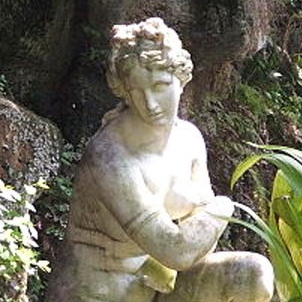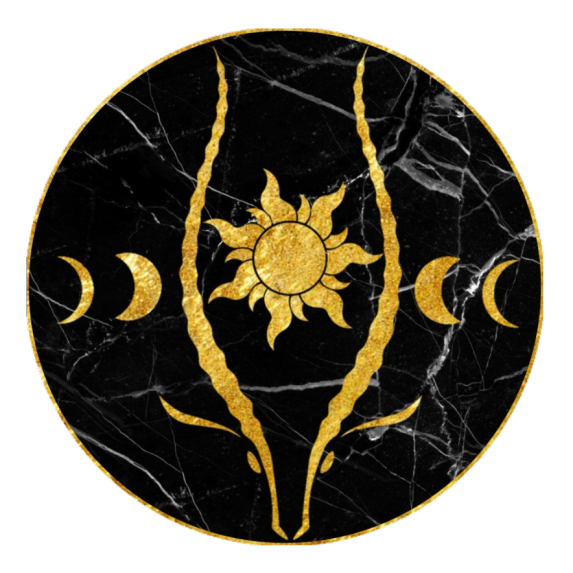So have you considered Allāt and Al’uzza? And Manāt, the third - the other one? - Quran 53:19-20. Well, let us consider Manāt, then. The earliest Quranic codices spell Manat as mnwt which is the same spelling we find in the Nabataean, Latin and Palmyrene forms of the name instead of mnāt which would correspond to the Classical Arabic pronunciation of the name. She is understood as a Goddess of fate and time so before we begin we must understand how ancient Arabs understood fate and time.
Manāyā and Dahr
There is time as we use the word today (زمن zamān - وقت waqt) and time as a symbol of life and death. Time is the determining factor of fate in pre-Islamic poetry and is not itself determined by some other power. Although time and fate are conceptually different, they are closely bound as seen in the multitude of terms used by Arab poets with dual meaning such as dahr (دهر), zamān (زمن era) and ayyām (أيام days) used for expressing reversals of fortune. The word dahr is used the most, and although it’s usually translated as eternity, dahr simply means a long time. Dahr could also mean nāzila (نازلة mischief from the heavens, literally, “coming down”) and one would attribute their misfortune to dahr. The oracle Satih, who interpreted a dream for the Yemeni king Rabia, said: “Time (dahr) sometimes is misfortune (dahārīr)”.
Then there’s manāyā (منايا destiny) which is more about individual fate or the preordained death of each individual while dahr or zamān is universal fate, or the impersonal fate of everyone. Dahr is fate-as-time that changes and wears things down while manāyā is fate-as-death. In poetry, manāyā is presented as a ruthless force that dooms humans, its indiscriminate and inevitable. From Zuhayr’s Mu’allaqa:
I regard Fate like the blows of a nearly blind she-camel, whomsoever it strikes, dies but whom it misses, lives on and ages.
Fate worries people and the occasions of relief are few and fleeting. This mood is captured well by the poet 'Adi ibn Zayd who said:
They lived a good life for a time, trusting restfully in their lot.
Then Fate turned against them in the same manner that it destroys mountains.
Thus Fate fires at the man in quest of livelihood circumstance after circumstance.
In the Greek tradition destiny was represented as a thread spun from a spindle while in ancient Arab poetry we also see the archetype of rope connected to destiny. Again from Zuhayr:
And whosoever fears the ropes of Fate will nevertheless be ensnared by them, even if one manages to ascend the courses of heaven with a ladder.
The poet Ṭarafa bin al-‘Abd stressed that human beings are linked to fate-as-death by rope. It cannot be bargained or reasoned with:
By your life, swear that Death, so long as he misses a strong man, is surely as the loosened halter, both folded ends of which are in the hands of the owner of the animal.
So that, if he wishes, on any day, he leads him off his life by his reins. And he who is tied by the rope of death, will have to submit.
And in the Mu‘allaqa of 'Imru’ al-Qays, we see the Pleiades star cluster, al-Thurayyā in Arabic, tied by hemp ropes to the top of a rock:
Oh long night, dawn will come, but will be no brighter without my love. You are a wonder, with its stars held up as by ropes of hemp to a solid rock.
The Pleiades also shows up in a poem by Abīd ibn al-’Abras who mentioned “the Pleiades bringing evil fortune and good”:
And there shall surely come after me generations unnumbered, That shall pasture the precipices of Aikah and Ladud
And the Sun shall rise, and the night shall eclipse it, And the Pleiades shall circle bringing evil fortune and good
Related practices appeared in Arabia. People used rope to protect themselves from the evil eye. One poet’s parents were afraid the evil eye would harm him, so they took him to a sheikh (elder), who tied rope to his arm as an amulet. For this reason, the poet earned the nick-name Dhul-Rumma, (owner of rope). Some believed practitioners of witchcraft tied knots into rope to harm people. The traces of this art are reflected in the Quran where the believer seeks refuge “from the evil of the witches who blow into knots” (Q 113:4). The tradition says that the verses were revealed to Muhammad after magic was worked into his hair using a cord with knots, concealed under a stone at the bottom of a well. Another metaphor of Fate is the arrow, launched at unwitting victims like in the elegy of Rabīʿah bin Mukaddam:
But the arrows of Fate, whomsoever they strike, no medicine man nor sorcerer can avail.
And Labid’s Mu’allaqa:
Indeed, Fate’s arrows never miss their mark.
Kahins (oracles/seers) would use bows to symbolically catch and shoot these arrows. Looking at the examples above, ancient Arabs were far from revering dahr or manāyā as divine. Due to the mortal fear of desert life, sudden misfortune, and the uncertainty of the future, they imagined this power in their poetry to be pretty hostile and viewed it negatively. A few centuries earlier we find the term rġm mny in Safaitic inscriptions always in a funerary context as an expression of grief for the deceased. The dead were “struck down” (raġām or raġm) by fate. The appearance of fate in these funerary contexts suggests that the force was regarded much in the same way as in the pre-Islamic poems; it was the ultimate cause of death. Many prayers request escape from the manifestations of fate: misfortune and adversity. There is no need to exhaust the examples given in Al-Jallad’s work on Safaitic religion in the section titled Fate.
There are no prayers to manāyā itself, nor are there any attempts to appease it. This absence suggests that Safaitic authors regarded it, much like pre-Islamic poets, as blind and cold, unresponsive to invocations and indifferent to offerings. While a number of authors called out to the Gods to be saved from manāyā, one text illustrates the limitations of divine intervention and echoes the later stoicism of pre-Islamic poets. Fate may be avoided, but ultimately it prevails and everyone meets their death:
He stopped again while going to water and remembered the dead and grieved, so O Allāt, grant long life to your righteous worshipper and protect [him] but from death there is no deliverance.
Indeed, the only solution is stoic acceptance as seen in a verse from the Muffaddaliyat:
And of a truth I know and there is no averting it that I am destined to be the sport of Fate; but dost thou see me wailing thereat?
and the adoption of a hedonistic attitude towards mortality as Ṭarafa said:
By your life, the time is not, except borrowed; so provision yourself with what you can from the goodness of it.

